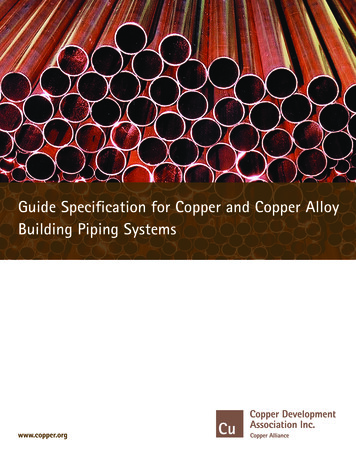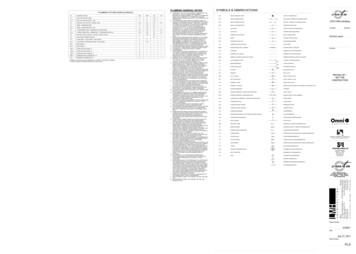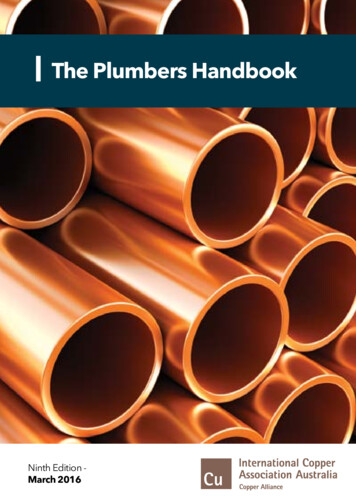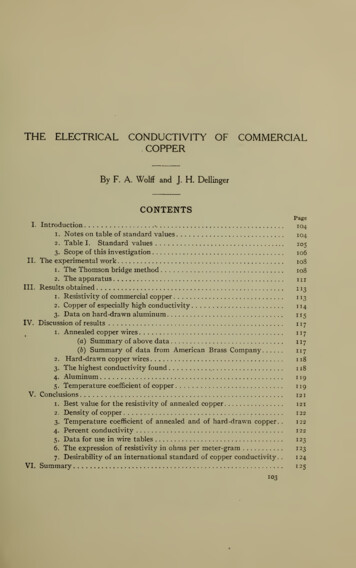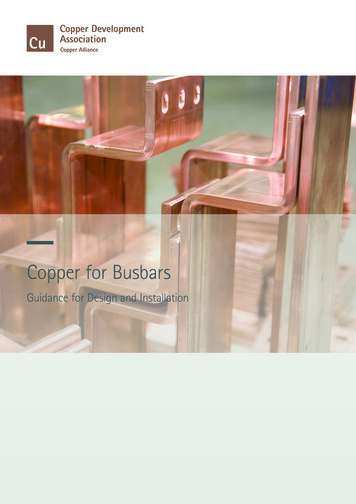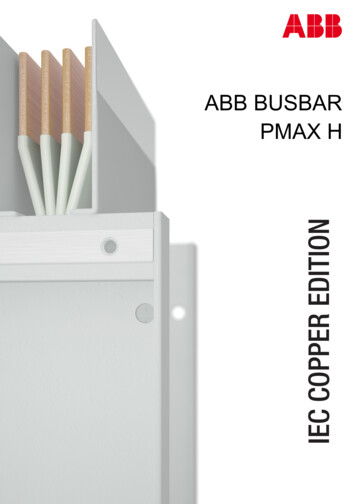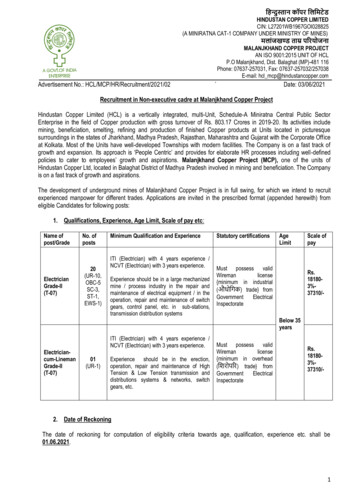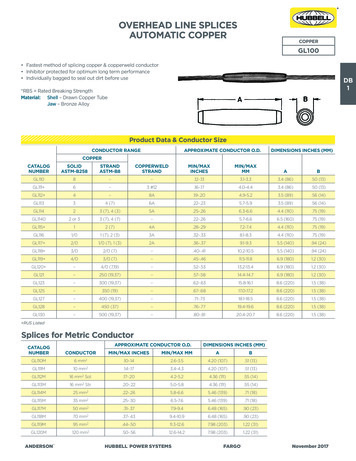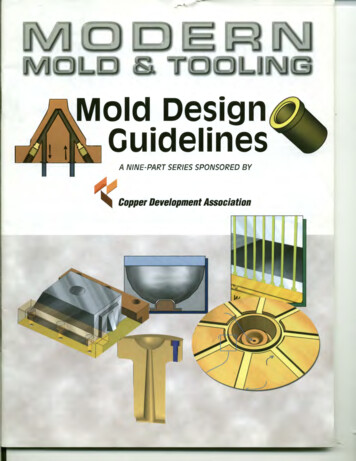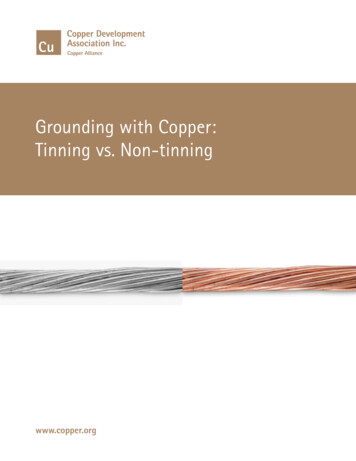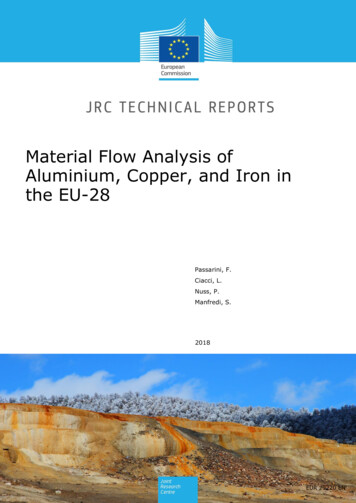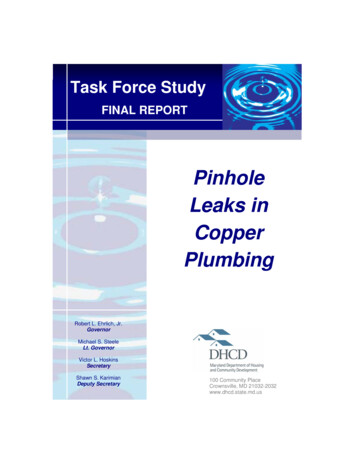
Transcription
Task Force StudyFINAL REPORTPinholeLeaks inCopperPlumbingRobert L. Ehrlich, Jr.GovernorMichael S. SteeleLt. GovernorVictor L. HoskinsSecretaryShawn S. KarimianDeputy Secretary100 Community PlaceCrownsville, MD 21032-2032www.dhcd.state.md.us
State of MarylandFinal Report: Task Force to Study Pinhole Leaks in Copper PlumbingExecutive SummaryThe Task Force to Study Pinhole Leaks in Copper Plumbing was established under the auspicesof Senate Bill 54, 2003, in order to help Marylanders understand the pinhole leak phenomenon,and thus deal with its consequences. Pinhole leaks pose problems for several reasons: They may cause water damage to plaster and sheetrock walls, electrical systems, flooring,ceilings or furniture;Undetected water leakage may result in mold growth;Repairing or replacing copper pipe, because of limited access, is generally costly;Water damage claims may result in homeowners’ insurance premiums being raised, ornon-renewal of policies.Possible causes to the pinhole leak problem are offered in this report, although it is widelybelieved that there is no one cause; and there is no one solution. Rather, it is generally held that anumber of circumstances may contribute to the problem, and a variety of remedies may beavailable for consideration.In order to answer the charge set forth in Senate Bill 54, the Task Force established threesubcommittees: Water Treatment and Quality, which dealt with water chemistry, water treatmentpractices, and water additives;Materials and Installation, which studied copper plumbing design, manufacturing andinstallation practices, and also researched other materials used in plumbing systems;Insurance, which investigated the effect of pinhole leak incidents on homeowners’insurance coverage.This report examines the extent of the problem in major water suppliers’ areas of the state anddiscusses the physical elements of the pinhole leak problem, including public water suppliers,sources of water, the water treatment process, copper piping, corrosion, and the effects ofcorrosion on copper pipe. The report then moves to regulatory issues, with emphasis on rules setforth by the U.S. Environmental Protection Agency, and the effects of those rules on waterconditions. The Safe Drinking Water Act protects the public health by regulating the nation’spublic drinking water supplies. The Lead and Copper Rule protects the public by minimizing leadand copper levels in drinking water; and the Stage 1 Disinfectants and Disinfection Byproducts(D/DBP) Rule reduces health risks by regulating the allowable concentration of disinfectionbyproducts in the drinking water. This D/DBP Rule has been successful, for example, in reducingthe overall risk of cancer. Unfortunately, the water treatment processes that reduce theconcentration of disinfection byproducts may increase the incidence of corrosion in copper pipeand other piping materials based on recent water research.iDecember 2004
State of MarylandFinal Report: Task Force to Study Pinhole Leaks in Copper PlumbingIn the section on Insurance, the report examines underwriting, since insurers have always usedloss histories as a tool for rating eligibility of the prospective policy holder for coverage. Thissection describes the Comprehensive Loss Underwriting Exchange (CLUE) and A-Plus Reportsand explains the effects of pinhole leaks on insurance coverage, including what options theconsumer may consider when advised by their insurer that their policy may be cancelled or theirpremiums may increase. The options for consumers whose policies have been cancelled in thenormal insurance market are explored as well.Finally, the Task Force offers in this report a list of recommendations, sorted by category, for thereader’s convenience. It should be emphasized that these are recommendations only and are theresult of the group's study of the problem - by researching available written research, byinterviewing various guests who appeared before the Task Force (expert scientific presentationsby Dr. Marc Edwards of the Virginia Polytechnic Institute and State University (Virginia Tech)and Bob Buglass of Washington Suburban Sanitary Commission (WSSC), and others) as well asinformation gleaned from a poll of Maryland water suppliers.The Task Force advises that, although specific causes have yet to be finitely determined, muchresearch is underway; and options for prevention, as well as for mitigation of this problem, areavailable. Although the Task Force has now completed its charge, it is hoped that the watersuppliers and the copper industry will sponsor further research and support these beginningefforts to solve the pinhole leak problem.George C. Eaton, Chairman, DesigneeTask Force to Study Pinhole Leaks in Copper PlumbingDecember 2004iiDecember 2004
State of MarylandFinal Report: Task Force to Study Pinhole Leaks in Copper PlumbingTable of ContentsExecutive Summary.iTable of Contents.iiiList of Figures and Tables . viDisclaimer .viiIIntroduction . 1A.The Problem of Pinhole Leaks . 1B.Senate Bill 54 . 1Definition Used by the Task Force. 1C.The Task Force. 3Organization . 3Methodology . 4II.Background.4A.Communities Affected and Timeframe . 4B.Extent of Known Pinhole Leaks in Maryland . 5Prince George’s and Montgomery Counties . 5Anne Arundel County . 8Baltimore City and County. 9Carroll County . 10Frederick County . 10Individual Water Sources . 10Outside Maryland . 10C.Insurance Issues . 101.Insurance Underwriting and Rating. 10Comprehensive Loss Underwriting Exchange (CLUE) and A-PLUS Reports . 112.Effects of Pinhole Leaks on Homeowners’ Insurance. 11Policy Limitations and Eligibility for Insurance . 11Distinguishing Types of Damage . 12Non-Renewal or Cancellation of a Policy . 12Obtaining Insurance Coverage when Adverse Action Occurs . 12III.The Physical Elements of the Problem . 13A.Water . 13iiiDecember 2004
State of MarylandFinal Report: Task Force to Study Pinhole Leaks in Copper PlumbingPublic Water Suppliers . 13Sources of Water . 13Impurities in Water. 14B.Water Treatment Process. 14Surface Water . 14Coagulation and Flocculation. 15Sedimentation . 15Filtration . 16Disinfection . 16pH Adjustment . 16Corrosion Control. 16Groundwater Treatment. 17C.Copper Piping (Tubing). 17Other Piping . 18D.Corrosion . 18Copper Corrosion . 18Pitting Corrosion . 18E.IV.Effects of Pitting Corrosion. 19Regulatory Issues . 19A.Safe Drinking Water Act . 19B.Lead and Copper Rule. 19C.Disinfectants and Disinfection Byproducts Rule . 20D.Interim Enhanced and Long Term 1 Enhanced Surface Water Treatment Rule . 20V.Possible Causes of Pinhole Leaks .20A.Research Related to the WSSC Water System. 21B.Other Reports . 25C.Copper Plumbing Materials. 26D.Installation and Workmanship. 26E.Design Issues. 26F.Reduced Natural Organic Matter (NOM). 26G.Other Chemicals in Water . 27H.Exterior Factors . 27ivDecember 2004
State of MarylandFinal Report: Task Force to Study Pinhole Leaks in Copper PlumbingVI.Recommendations.28A.Home Purchaser’s Role (When considering the purchase of a home) . 28B.Home Owners with Pinhole Leaks Problems . . 28C.Home Inspectors. 29D.Water Suppliers . . 29E.Plumbers and Home Improvement Contractors . . 30F.Training and Information . 31Conclusion .32APPENDIX A: FACT SHEET .34APPENDIX B: SENATE BILL 54 .36APPENDIX C: AREAS REPORTING LOW INCIDENCE OF PINHOLE LEAKS.38APPENDIX D: SOURCES. 41APPENDIX E: ABBREVIATIONS AND GLOSSARY . 47APPENDIX F: USEFUL WEB SITES AND PHONE NUMBERS.49APPENDIX G: MARYLAND RESIDENTIAL PROPERTY DISCLOSURE ANDDISCLAIMER STATEMENT.50vDecember 2004
State of MarylandFinal Report: Task Force to Study Pinhole Leaks in Copper PlumbingList of Figures and TablesFigure 1: Pipe with Pinhole Leak (Courtesy of WSSC). 2Figure 2: Shows Further Details of Pinhole Leak (Courtesy of WSSC) . 3Figure 3: Pinhole Leaks by Community in WSSC Area, June 2004. 5Figure 4: Pinhole Leaks by ZIP Code in WSSC Area, June 2004 . 6Figure 5: Pinhole Leaks per 1,000 Customers by Decade of Construction in WSSC Area, June2004 . 7Figure 6: Pinhole Leaks by Pipe Orientation in WSSC Area, June 2004. 8Figure 7: Baltimore County Water Sources (Courtesy of Baltimore DPW). . 9Figure 8: Typical Surface Water Treatment (Courtesy of WSSC). 15Figure 9: Pipe from Arlington, Virginia Water System with Clamps to Stop Pinhole Leaks(Courtesy Dr. Marc Edwards) . 22Figure 10: Dried Copper Surfaces After 6 months’ Exposure to WSSC Water and AluminumSolids . 24Figure 11: Copper Pipe Samples at the End of the Experiment. . 25Table 1: Other Counties of Maryland. 40viDecember 2004
State of MarylandFinal Report: Task Force to Study Pinhole Leaks in Copper PlumbingDisclaimerThe report of this Task Force does not invoke any legal or regulatory authority of the State ofMaryland, nor does it assign any legal culpability to any party mentioned in this report. Anyinformation contained in this report should not be construed as legal or regulatory advice on anysubject matter. No reader of this report should act or refrain from acting on the basis of anycontent included in, or accessible through, the report, without seeking the appropriate legal orother professional advice on the particular facts and circumstances at issue from professionalslicensed in the recipient's state, country or other appropriate licensing jurisdiction.The Task Force has made reasonable efforts to ensure that all information provided through thisreport is accurate at the time of inclusion. However, there may be inadvertent and occasionalerrors. It should not be taken as a definitive guide to every area of concern, nor should it beconsidered sufficiently full and accurate to cover every situation.Mention of trade names or commercial products does not constitute endorsement orrecommendation for use.viiDecember 2004
State of MarylandFinal Report: Task Force to Study Pinhole Leaks in Copper PlumbingIIntroductionA.The Problem of Pinhole LeaksPinhole leaks pose a problem to property owners for several reasons. They may cause waterdamage to walls, electrical systems, flooring, ceilings, or furniture. Undetected water caused bypinhole leaks may result in mold growth. Repairing or replacing pipe may be costly. Finally,water damage claims might result in homeowners’ insurance premiums being raised or insurancecompanies not renewing homeowners’ policies.B.Senate Bill 54The recent concerns about pinhole leaks in copper plumbing prompted the State of Maryland toestablish a task force to examine the phenomenon and recommend possible solutions. Thisdocument summarizes the efforts of the Task Force in fulfilling Senate Bill 54.The Bill states in part:“(f) The Task Force shall:(1) determine the extent, patterns, and trends of pinhole leaks in Maryland;(2) investigate the possible causes of pinhole leaks in copper plumbing,including: water chemistry requirements adopted by the EPA; water treatmentpractices; water additives; copper plumbing design, manufacturing, andinstallation practices; and copper plumbing cleaning and lining practices;(3) investigate the effect of pinhole leaks in copper plumbing on homeowners’insurance coverage; and(4) make recommendations regarding possible remedies for pinhole leaks incopper plumbing and possible steps for Maryland residents to take if theyexperience a problem with pinhole leaks.(g) The Task Force shall report its findings and recommendations to the GeneralAssembly on or before December 31, 2004.”Because of the Task Force’s mandate, this report covers pinhole leaks in water pipes made ofcopper, and their effects and not other types of problems that plumbers, homeowners, andinsurers have encountered.The primary focus of the report is on public water supply systems. Much of the State of Marylandis served by wells. There are risks to copper pipes from untreated well water, but this issue wasnot the basis for concerns that
and Bob Buglass of Washington Suburban Sanitary Commission (WSSC), and others) as well as . licensed in the recipient's state, country or other appropriate licensing jurisdiction. . copper, and their effects and not other types of problems that plum
